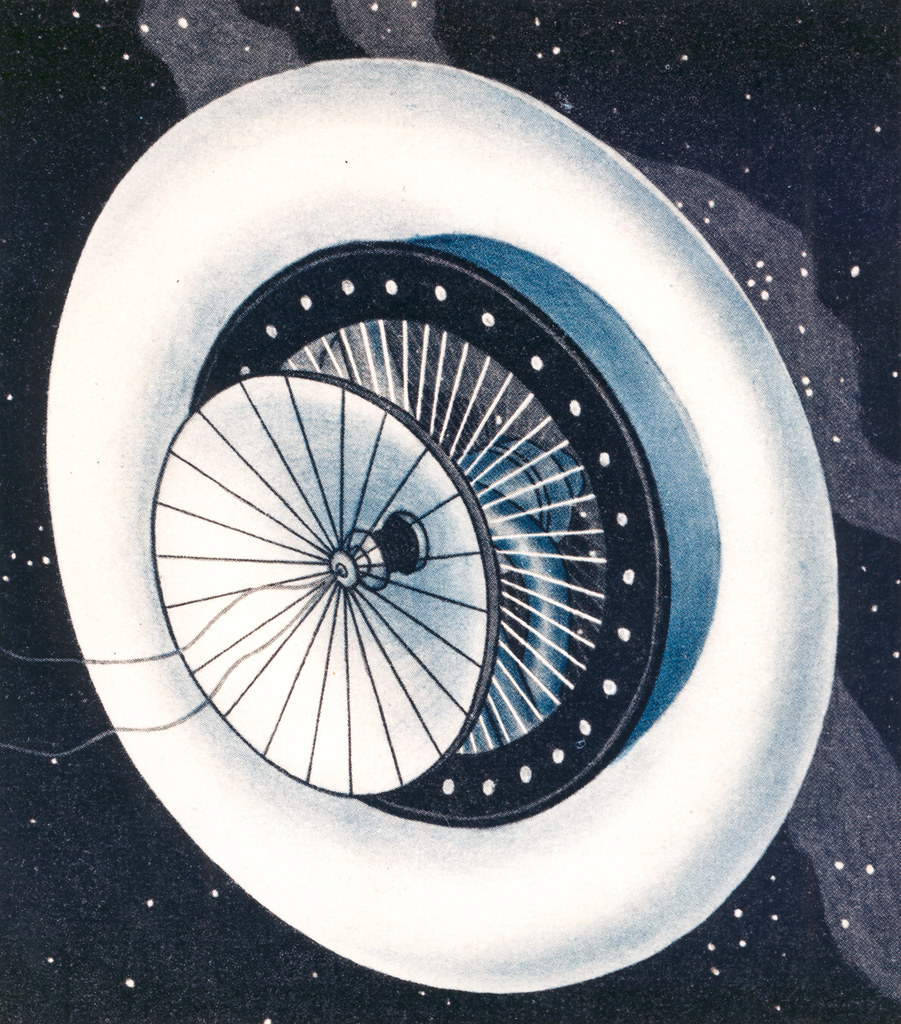#hermann noordung
Text
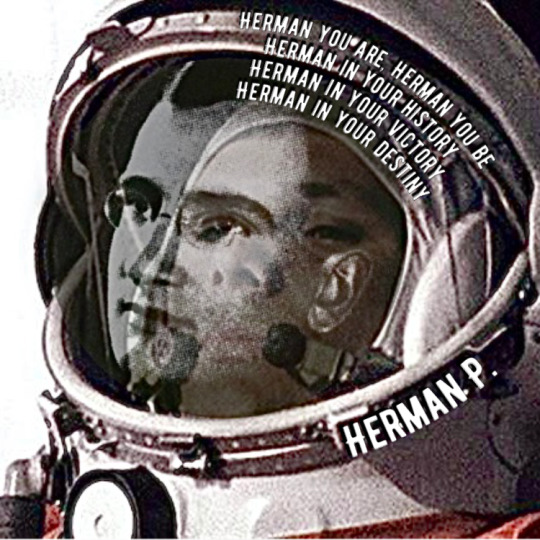
'Herman P.'
Digital Collage, 2023
I took the lyrics of 'Roman P.' by Psychic TV and changed 'Roman' to 'Herman'
Lyrics:
Herman you are, Herman you be
Herman in your history
Herman in your victory
Herman in your destiny
[Chorus:]
Are you free, are you really free?
Are you really, really, really, really, really free?
Is it you or is it me?
Or is it simply history?
Are you free, are you really free?
Are you really, really, really, really, really free?
Is it you or is it me?
Or is it simply jealousy?
...
Oh, oh Herman, oh Herman
Herman P.
#hermann noordung#herman potocnik#nsk#nsk folk art#neue slowenische kunst#neue sorbische kunst#spacehistory#spacetravel#roman p#psychic tv#genesis p orridge#yuri gagarin#space pioneer#der raketen motor#nsk state lipsk#nsk lipsk#nsk state in time#sb2130#Cosmokinetic Cabinet Noordung#Red Pilot Theater#Gledališče sester Scipion Nasice#center noordung#The Problem of Space Travel#Das Problem der Befahrung des Weltraums#Raketen Motor#Cultural Centre of European Space Technologies#KSEVT
4 notes
·
View notes
Photo

one of the first depictions of a space station, 1929, by Herman Potočnik (aka Hermann Noordung)
24 notes
·
View notes
Photo
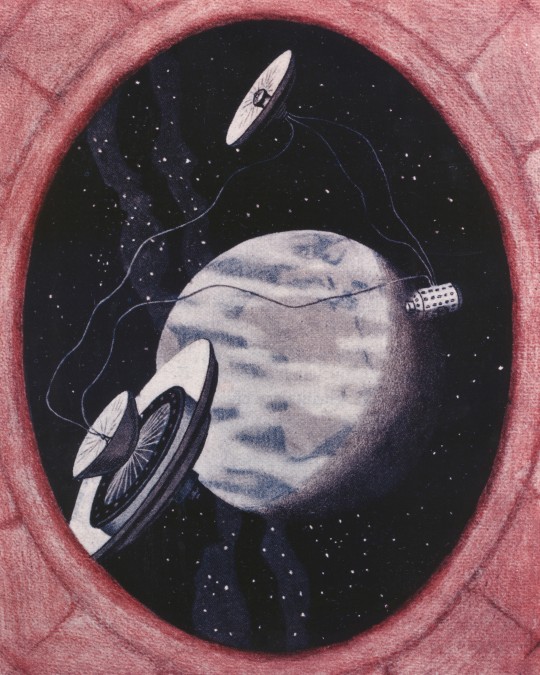
one of the first depictions of a space station, 1929, by Herman Potočnik (aka Hermann Noordung) via RetroFuturism
14 notes
·
View notes
Text
According to wikipedia "a skeuomorph is a derivative object that retains ornamental design cues (attributes) from structures that were necessary in the original. Examples include pottery embellished with imitation rivets reminiscent of similar pots made of metal and a software calendar that imitates the appearance of binding on a paper desk calendar."
In this Amazing Stories cover (image 1), the space station was clearly inspired by Von Braun's "Man Will Conquer Space Soon" design (image 2); but the parabolic reflector on Von Braun's station (which was intended to focus sunlight to boil mercury and generate electrical power for the station) has , on the Amazing cover, morphed into a generic greeblie.
Most SF stations are skeuomorphic, really. Early real-world designs, like Hermann Noordung's 1929 space wheel (image 3, 4) were donut-shaped so that they could spin to provide centrifugal gravity. Nearly a century later the donut-shaped space station has become firmly embedded in the cultural imagination, and fictional space stations like Deep Space Nine (image 5), or Federation Space Command from Blake's 7 (image 6) are toroidal even when they generate gravity through other means.
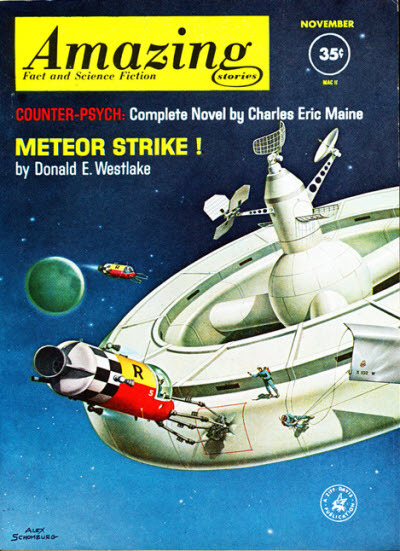

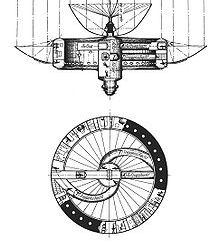


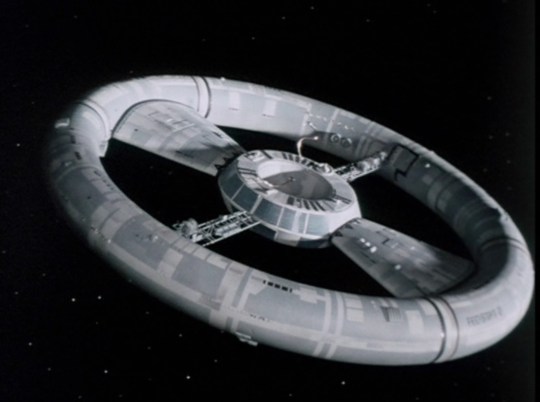
16 notes
·
View notes
Photo


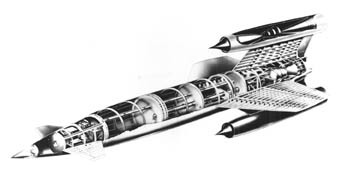

SPACE STATIONS AND WINGED ROCKETS
Cargo rocket of the Collier's series, with winged upper stage.
Hermann Noordung's space station concept of 1929.
Navaho concept of 1948.
The X-24B, a lifting body capable of supersonic flight.
https://history.nasa.gov/SP-4221/ch1.htm
3 notes
·
View notes
Video
(via Noordung's Space Station Habitat Wheel | 1929 Hermann Noordu… | Flickr)
0 notes
Text
Space Laws Across the Globe & Its Evolution
“Space law is the law meant to regulate relations between States to determine their rights and duties resulting from all activities directed towards outer space and within it – and to do so in the interest of mankind as a whole to offer protection to life, terrestrial and non-terrestrial, wherever it may exist.”
– Lachs M., The law of outer space – An experience in contemporary law-making, 1972, p. 33
Space Law is the field of law that governs activities related to space. Satellites, space invasions, new outer- space discoveries, space exploration, use of weapons, rescue operations, environmental degradation etc, have all been given a legal connotation that’s called space law. It encompasses both domestic and international agreements but the main issue that arises under space law is that who will be the governing body when conflicts like these arise? Essential objectives of space law are to guarantee a sane, dependable way to deal with the exploration and utilization of space for the advantage and in the public interest for all mankind.
International space law evolved in parallel with the development of space technology and, as a result, remained insignificant until the start of the Space Race. Therefore, it consisted mainly of just suggestions, discussions, speculations, and the human imagination that had driven a passion for exploring the unknown.
Firstly, it is necessary to stress the importance of space science, which is still the “driving force” of everything connected with international space law. Without scientific discoveries there would be no need to regulate space affairs by law.
With the advancement of rocket science, questions about the legal regulation of aviation appeared on the world’s agenda. The swift development of international aviation attracted the attentions of lawyers and academics, as well as of government officials and military commanders. In 1910 Emile Laude noted that there special laws were needed for outer space as a region. In 1926 V. A. Zarzar of the Soviet Air Ministry indicated his view that there was an upper limit to a state’s sovereignty over its airspace, and that a separate legal regime would be required to deal with the arena beyond this ‘upper zone’. It is fascinating that already in 1928 Herman Potočnik (pseudonym Hermann Noordung December 22nd, 1892 – August 27th, 1929) the rocket engineer and pioneer of cosmonautics (astronautics) of Slovenian ethnicity published his book ‘The problem of space travel: The rocket motor’, in which he presented a plan for a breakthrough into space and the possible establishment of permanent human presence, i.e. long-term human habitation of space, by building a space station that would be positioned in the geostationary orbit. His speculation foresaw the possibility of using space stations for possible Earth observations. His work is especially acknowledged from a technical point of view although he did not address the legal issues of space in regard to international law.
The UN has been involved in outer space-related activities from its conception under the UN Charter for the progressive development of international law and through the Committee on the Peaceful Uses of Outer Space (hereafter UNCUPOUS), especially in terms of overseeing a legal framework regarding outer space through its Legal Subcommittee. It has introduced five international legal instruments governing space activities that have all entered into force – t.i. Corpus Iuris Spatialis Internationalis, and the General Assembly has adopted five sets of Principles governing activities in outer space, also known as Space Resolutions. Therefore, the UN instigated the basis for what has become a separate and distinct discipline within the field of international law, i.e. international space law.
Furthermore, international law which applies to outer space is also included within the UN Charter and this obliges all UN members to settle disputes by peaceful means and prohibits the threat of or actual use of force against the territorial integrity or political independence of another state. The charter also recognises a state’s inherent right to act in individual or collective self-defence
Primarily, the United Nations Office for Outer Space Affairs commonly referred to as the UNOOSA is tasked with the mission of promoting international co- operation and the peaceful use of outer space. Under this UNOOSA, there are five more treaties- but to carefully note- it is only binding on the member states that have ratified it. While discussing these five more treaties, we’ll also be taking a look at the various space legislations enacted by different countries.
The Moon Treaty- The Agreement Governing the Activities of States on the Moon and Other Celestial Bodies
The Registration Convention- The Convention on Registration of Objects Launched into Outer Space
The Liability Convention- The Convention on International Liability for Damage Caused by Space Objects
The Rescue Agreement- The Agreement on the Rescue of Astronauts, the Return of Astronauts and the Return of Objects Launched into Outer Space
The Outer Space Treaty- The Treaty on Principles Governing the Activities of States in the Exploration and Use of Outer Space, including the Moon and Other Celestial Bodies
Out of all these five treaties, the Outer Space Treaty is the most important one. It gives us a wholesome view of the space law regulations, and clearly lays down that the space is no one’s property. It can be used and explored by anyone, but anyone who wishes to operate in outer space, must do it peacefully, which means there cannot be any country who has the right to establish any military base in outer space. No member nation of the UNOOSA or for that matter, no country can own a land or any celestial or extra- terrestrial body. The moon and the stars are nobody’s and everybody’s- no country or body of organizations, not even the UNOOSA, can just plant their flag in outer space and claim that the particular property belongs to them. Representing their country as an astronaut, does not confer the right to ownership to that person, in outer space. An astronaut as soon as he steps out of his country’s space vessel, and steps on to the celestial body, cannot appropriate it to his own benefit. The celestial bodies are accessible to all without any discrimantion or unlawful intervention, but it must benefit everyone, and without any contamination caused to the environment, since space is an area without defined boundaries.
Following is an overview of some national space laws and national regulatory frameworks enacted by different countries-
United States- The National Aeronautics and Space Administration is the world leader when it comes to space exploration. While the NASA has left no stone unturned in being the dominator in outer space, it is the only federal agency of the USA who in consonance with the UNOOSA principles and conventions has adopted similar peacekeeping rules such as anti military measures, environmental preservation etc.
Russia- Russian space activities are governed under the statute- Law of the RUSSIAN FEDERATION “ABOUT SPACE ACTIVITY”, which is the constitution for the Russian Space Agency is further divided into chapters and articles which govern Russia’s actions in the outer space. Since Russia is a party to the UNOOSA, Article 26 of the above mentioned statute creates an obligation on the nation to ensure international cooperation as stated in the Outer Space Treaty.
India- Indian Space Research Organisation is the Indian space agency operating under the Government of India, which harnesses space technology and exploration for national development and international co- operation in the global community. It enacts its own legislations with the approval of UNOOSA.
The post Space Laws Across the Globe & Its Evolution appeared first on Legal Desire.
Space Laws Across the Globe & Its Evolution published first on https://immigrationlawyerto.tumblr.com/
0 notes
Photo

Noordung's Three-Unit Space Station Concept
This 1929 Hermann Noordung image depicts a three-unit space station as seen from a space ship. Hermann Potocnik (1892-1929), also known as Herman Noordung, created the first detailed technical drawings of a space station. The three units were the habitat, the machine room, and the observatory, each connected by an umbilical. The Earth is in the background, approximately 26,000 miles away. The station in this image is roughly above Cameroon's southern tip, in a geosynchronous orbit on the median of Berlin.
just like here
via GRIN
55 notes
·
View notes
Text

'Herman P.'
Digital Collage, 375 x 375 mm, 2023
Metallic UltraHD Print under Acrylic Glass,
Black Aluminium Art Box
After setting up the 'XXX years of Zonic' exhibition and the associated intensive examination of my 30-year-old works - the 'timeline pictures', the idea for a new work came to me in the afternoon before the exhibition opening, which I immediately began to create a series of new 'timeline images'.
The computer-generated 'timeline images' of the first generation from the beginning of the 1990s also had technical reasons that led to their realization. I wanted to continue to serve these limitations, which lead to creative creativity - but to reinterpret them. I translated the former canon of shapes into new templates that can be used with simple graphic tools on mobile devices to create new images without having to use powerful programs like Photoshop and the like.
Terms such as folk art or folklore from the universe of New Slovenian Art/New Sorbian Art (NSK) are to be taken literally here and are taken seriously by me. In parallel to formal templates, I have created a collection/database of folkloristic elements of socialist propaganda art or folkloristic clip art, which I use as illustrative quotes. I have been working intensively on new pictures over the last two months, which I would like to present now.
It begins with the work 'Herman P', which is dedicated to the Slovenian space pioneer Herman Potočnik (Hermann Noordung). The lines of text used are taken from the song 'Roman P.' by Psychic TV and only the modified syllables of the first name have been changed.
Without the groundbreaking scientific work of Herman Potočnik (1892-1929), space stations and people living on them in space would never have been possible. So I superimposed Potočnik's portrait with Gagarin's (1961 the first man in space). Since Herman Potočnik tragically died shortly after the publication of his book “The Problem of Traveling into Space – The Rocket Engine” he never saw his work bear fruit. Now he walks as a good spirit or accompanying revenant on every mission in space.
#sb2130#NSK#Neue Sorbische Kunst#NSK State Lipsk#Hermann Noordung#herman potocnik#nsk folk art#nsk state in time#Space Travel#Roman P#Psychic TV#leipzigartist#Zeitstrahlbild#Zonic
0 notes
Text


Hermann Noordung Sneaker / 2022
As an absolute space fan, I finally designed skater sneakers in honor of the Slovenian space pioneer Herman Potočnik (1892 - 1929) and had them made by Vans. Due to the fact that Vans cannot embroider special Slavic characters, I chose Potočnik's pseudonym Hermann Noordung.
To learn more about Herman Potočnik please visit Wikipedia:
https://de.wikipedia.org/wiki/Herman_Potočnik
https://en.wikipedia.org/wiki/Herman_Potočnik
#NSK#Neue Sorbische Kunst#Neue Slowenische Kunst#NSK State in Time#NSK State Lipsk#Space#Space Pioneer#Hermann Noordung#Herman Potocnik#Slovenia#Vans#Sneaker#Irwin#spacetravel#sb2130#Gledališče sester Scipion Nasice#Red Pilot Theater#Cosmokinetic Cabinet Noordung#center noordung#Cultural Centre of European Space Technologies#The Problem of Space Travel#Rocket Motor#Das Problem der Befahrung des Weltraums#Raketen Motor#KSEVT
1 note
·
View note
Text
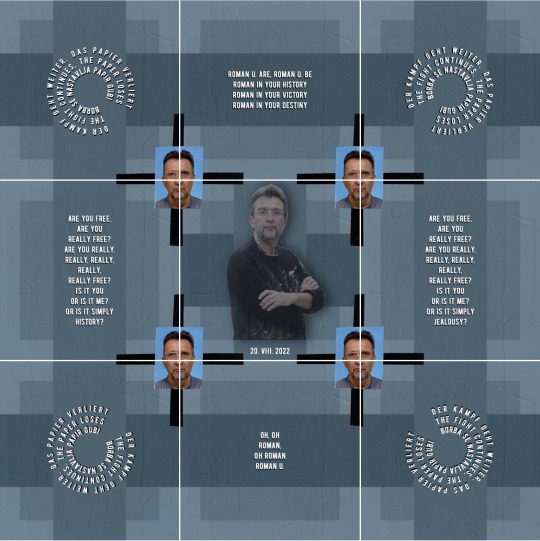
'Roman U.’
Digital Collage, 375 x 375 mm, 2023
Fine Art Pigment Print under Acrylic Glass,
Black Aluminium Art Box
Back in 1988 I got my hands on the vinyl album ‘Let it Be’ by the Yugoslavian band Laibach. The album contains cover versions of the Beatles album of the same name. What impressed me most was the cover artwork, which interpreted the four portraits of the musicians. It was designed by the Slovenian artist group Irwin, which, together with Laibach, is part of the Neue Slowenische Kunst concept. Although it was only a very small glimpse through the Iron Curtain for me at the time, this LP had a huge influence on my artistic work. I spent hours studying the artwork.
On the occasion of the 1st NSK Folk Art Biennale 2014 in Leipzig, I had the opportunity to get to know the Irwin artist group personally. In my experience, Roman Uranjek was the most open and funniest of the group. After the exhibition we were in contact via Facebook. He was very active on Facebook and we followed our work.
In June 2022 he was the first to like pictures of my Hermann Noordung sneakers. A few weeks later I received the news of his sudden death, which shocked me greatly. For these reasons, this is also my most personal work in this series. I struggled for a long time with myself about giving an artistic commentary.
The catalog for the current Irwin exhibition “What is Art, Irwin?” at HMKV comes with a trigger warning. Roman Uranjek, my personal tragic hero. The picture is dedicated to him.
#sb2130#Roman Uranjek#NSK#Neue Sorbische Kunst#Neue Slowenische Kunst#Irwin#NSK Folk Art#Leipzig Artist#Slowenia#Laibach#Ljubjana
0 notes
